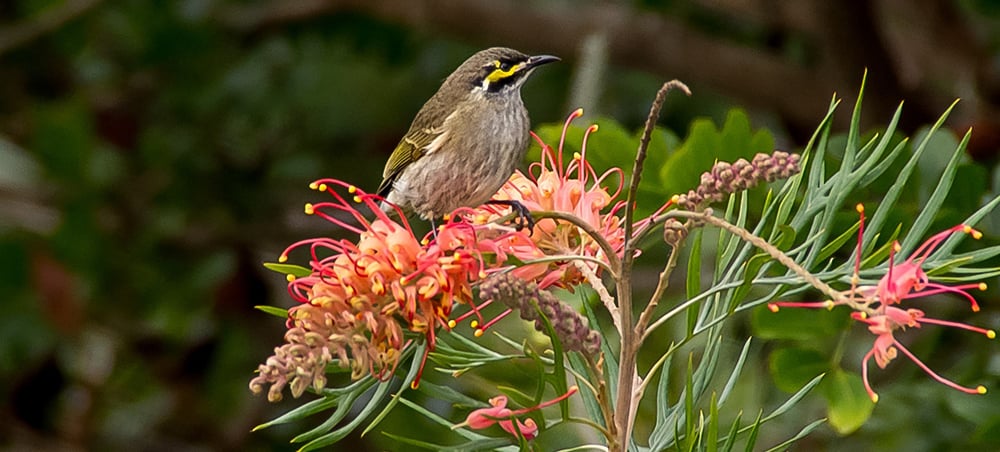With this summer tipped to be hot and dry, our bushland team has some helpful advice on how to prepare your garden.
The National Trust (NSW) has a team of more than 40 bushland experts who plant and maintain green spaces across New South Wales. They’re used to extreme gardening conditions and the challenges of long, hot Aussie summers.
Regional Manager of Bushland Management Services, Allana Sheard, is currently working on a project for City of Sydney, planting over 300 native flowering plants into public garden beds in Sydney’s Glebe.
She says that native plants are naturally the best choice for Australian gardens since they survive on little water, look great all summer long, and give back to the local ecosystem. Here, Allana shares a few tricks for creating a thriving native garden that every gardener can apply at home.
See what grows in your local area
Allana says one of the best ways to get started is to see what grows naturally near your home. “Go for a local bushwalk and see what’s working well and what’s in flower. Often I’ll visit bushland that is the same aspect as my garden, then I’ll try and mirror what’s working there.”
If particular native plants are growing well in nearby bushland, chances are it will do well in your garden. Take a photo, then look for the same plant when you visit the nursery.

Have a plan
“We try to plant six plants every square metre,” says Allana. “So before you go to the nursery, measure out your garden bed beforehand, and keep the six-plant rule of thumb in mind. Often people don’t put in enough plants.”
Aim to have a good spread of native plants in the same area so they can support each other and create a mini micro-climate. Also think about the structure of your garden – good groundcover, shrubs and canopy trees will all work together for a healthy garden. See our full list of plants to try below.
Not all Australian natives are native to your garden
When we think showstopping native flowers, Grevilleas usually come to mind. But with over 300 species of Grevillea to choose from, Allana recommends doing some research and finding a species that’s endemic to your local area.
“Locally Indigenous plants have so many benefits. If you put in a Grevillea from another area, it looks lovely, but you might be attracting birds like Noisy Minors who will fight off native birds. Check with your nursery about which plants are native to your area – by putting in the right plants you’re helping the local fauna.”

Plant and water wisely
October and November are great times to plant Australian natives before the big heat sets in. Think small and buy seedlings rather than big established plants.
“We use seedlings for most of our plantings,” says Allana. “They’re more high maintenance at first, but the smaller roots allow them to establish quickly and in the end they’ll out-compete larger plants.”
Soil is also worth noting. Unlike cottage gardens that are rich in compost and manure, native garden beds prefer poorer, well-drained soil. You can mix some sand into normal soil, or apply fertilisers that are made especially for native plants.
Finally, keep the water strong and steady at first, then wind it back. “We water for eight weeks,” says Allana. “Water your seedlings three times a week for eight weeks, then gradually ease off to help your plants become self-sufficient. The beautiful thing about natives is that once established, you won’t need to do much at all.”

Ask your council for free plant giveaways
Some councils in NSW give away four free seedlings to local homeowners a few times a year. Allana recommends making the most of this service – not just for the free plants, but to also get tips from experts in your area.
“Free native plant giveaways are fantastic, and you can talk to the council staff and ask them which plant combinations work well. It’ll give you a really good idea of what you can plant in your area.” Check your local council website for details.
Try these plants
Here are some of the varieties Allana and the Bushland Management Services team will be planting in Glebe. Give them a go in your own garden:
SHRUBS
| Sydney Boronia (Boronia ledifolia) |
| Bossiaea (Bossiaea stephensoni) |
| Purple Burr-daisy (Calotis cuneifolia) |
| yellow burr-daisy (Calotis lappulacea) |
| Pink Matchheads (Comesperma ericinum) |
| White Correa (Correa alba) |
| Correa (Correa decumbens) |
| Crowea (Crowea saligna) |
| Eggs and Bacon (Dillwynia floribunda) |
| Grey Spider Flower (Grevillea buxifolia ) |
| Pink Spider Flower (Grevillea sericea) |
| Red Spider Flower (Grevillea speciosa) |
| White Everlasting Daisy (Helichrysum elatum) |
| Hovea (Hovea linearis) |
| Drumsticks (Isopogon anethifolius) |
| rice flower (Ozothamnus diosmifolius) |
GROUNDCOVERS AND GRASSES
Appleberry (Billardiera scandens)
Grass Daisy (Brachyscome graminea)
Cut-leaved daisy (Brachyscome multifida)
Common Everalsting (Chrysocephalum apiculatum)
Barb Wire Grass (Cymbopogon refractus)
Long Hair Plume Grass (Dichelachne crinita)
Saloop (Einadia hastata)
Hedgehog Grass (Echinopogon caespitosus)
Scrambling Lily (Geitonoplesium cymosum)
False Sarsaparilla (Hardenbergia violacea)
Snake vine (Hibbertia scandens)
Running Postman (Kennedia prostrata)
Lomandra multiflora (Lomandra multiflora)
Weeping Meadow Grass (Microlaena stipoides)
Basket grass (Oplismenus aemulus)
Poa (Poa affinis)
Chamomile Sunray (Rhodanthe anthemoides)
Wallaby Grasses (Rytidosperma caespitosum)
Fairy fanflower (Scaevola aemula)
Kangaroo Grass (Themeda australis)
Native violet (Viola hederacea)
The National Trust’s Bushland Management Services are pioneers in the field of bushland restoration and management. Find out more about their services in the Great Sydney region.
Be the first to find out about the National Trust (NSW)’s latest news and events. Sign up to our newsletter.

 Twitter
Twitter Facebook
Facebook Linkedin
Linkedin Email
Email
Very informative article.